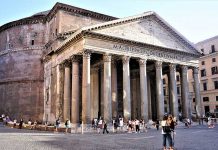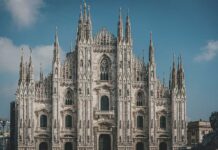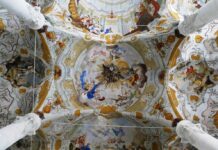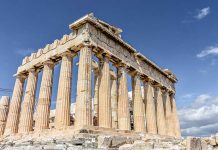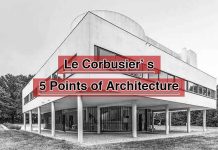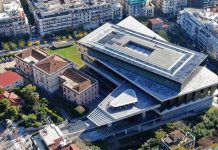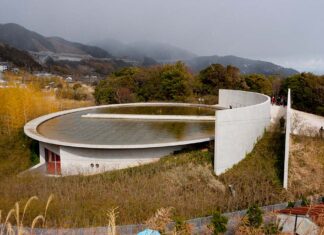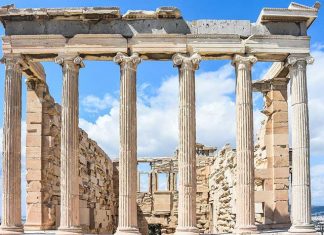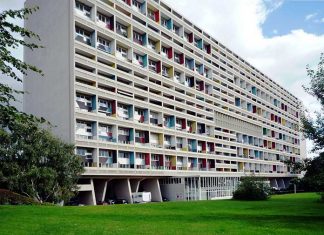| Architect: Isidore of Miletus and Anthemius of Tralles |
| Location: Istanbul, Turkey |
| Construction year: 532-537 |
| Structure material: Stone, Marble |
| Architectural style: Byzantine architecture, Ottoman architecture |
Hagia Sophia is one of the most talked about, argued and important structures in world history. A sanctuary of thousands of years, the heart of Constantinople and the headquarters of the city; the key to Istanbul. In this article, we’ll focus on the Hagia Sophia architecture and its historical significance.
Consider a structure that Eastern Rome was ruled from there in all its magnificence and the emperors were crowned there.
It has been the largest cathedral in the world for almost 1,000 years. Furthermore, it has served to 2 great religions, as the chief church for 916 years and 477 years as a mosque.
After this short brief, let’s start with the history of Hagia Sophia.
Hagia Sophia History
The word Hagia Sophia means “Sacred Wisdom” in Greek. Of course, neither this is the first name of the building nor today’s Hagia Sophia is the first structure that was built here.
The first church, called Megale Ekklesia, was built by Emperor Constantine in 360. This church had a wooden roof and a basilica plan. Unfortunately, its life did not exceed half a century.
Actually, it would be a great chance the unfortunate events that happened to many architectural masterpieces in history did not happen to this symbolic structure, which is the manifestation of such political and religious power.
As we all know, luck isn’t in favor of architecture. The church was destroyed in 404 as a result of a public uprising and has become unusable.
Not so much later, Hagia Sophia was rebuilt in a similar but larger structure after 11 years. This time, in the imperial seat, there was Theodosius II, known for his books, the laws and the kilometers-long city walls he made.
This structure, whose architect was Rufinos, took its place in the dusty pages of the history of architecture because of the “Nika Rebellion”, a greater uprising than before, carried out by a popular coalition against the empire, on January 13, 532.
The Dream of an Idealist Emperor
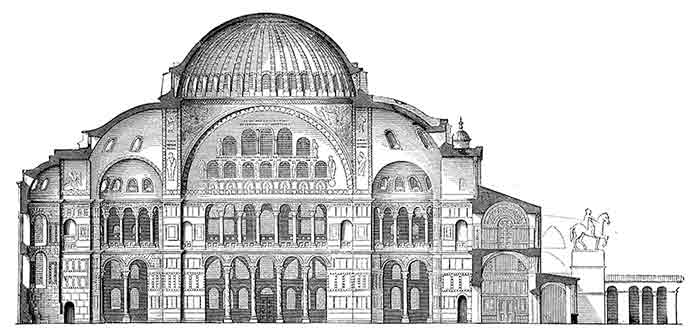
Without the Hagia Sophia, a symbol of great spiritual power, we do not know if the Eastern Roman emperors would rule all over the country with whole their might. But, the majestic reconstruction of Hagia Sophia, which was rebuilt with greater power every time it was destroyed, might be a clue to the answer to this question.
The building was designed by two great architects Isidore of Miletus and Anthemius of Tralles by order of Justinian in 532. They are known as the architects of Hagia Sophia.
Knowing that 100 architects, each with 100 workers at their disposal, worked on the structure and the structure was completed in an extraordinarily short time like 5 years, is quite important for us to see Justinian’s ideal of “Great Rome Again”.
This structure was so important for Justinian. According to the historian Prokopios, at the opening of the temple; the emperor pointed to the Temple of Solomon in Jerusalem, another of the most important religious buildings in history, by saying “O Solomon, I passed you”.
If such an ambitious statement had been said for another structure, not for Hagia Sophia, people would probably thought that Justinian had lost his mind.
However, with all its nobility and materials brought from many parts of the world, Hagia Sophia, which has a dome having a height of 55.6 m and a diameter of 31.87 m (north-south axis), deserves this credit.
White marbles from Marmara, green porphyries from Egriboz Island, pink marbles from Afyon, yellow marbles from North Africa, columns brought both from Egypt and the Temple of Artemis in Ephesus…
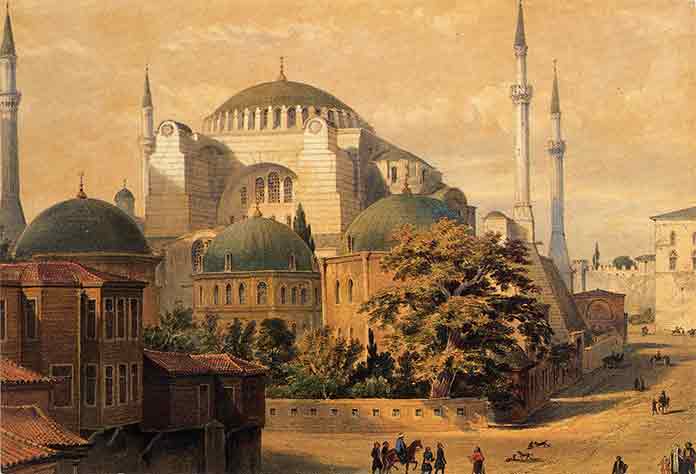
The third Hagia Sophia, unlike its predecessors, was planned both basilically and centrally. The square center carries a huge dome with the angel-figured 4 pendentives, showing the mastery, experience and high mathematical knowledge of architects.
Having 3 naves, 1 apse and 1 inner and outer narthex, the structure has 5 doors in the outer corridor and 9 doors in the inner corridor. There is a rumor that the big door in the middle, which the emperor and his relatives had used, was made from the remains of Noah’s ark.
The most famous of the 104 columns of Hagia Sophia, which have 40 in the lower and 64 in the upper gallery, is the “Wishing Column”. The name comes from a superstitious belief.
People who touch the cavity in that column and put the liquid in their hands to their wounds believe that they will recover. Perhaps this belief would not have existed if this column, which was said to drain the tears of the Virgin Mary, didn’t cure Justinian’s headache.
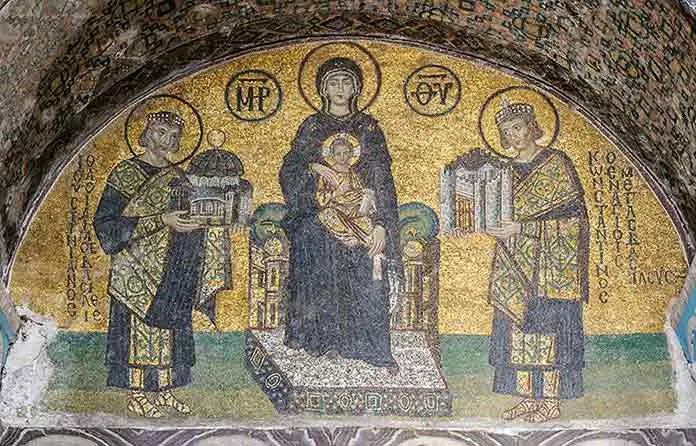
The things that make Hagia Sophia fascinating are not only the proportions or the architecture but also the gorgeous mosaics that make a strong connection with the building and represent various scenes.
The Presentation Mosaic on the Vestibule Gate of the inner narthex depicts the Virgin Mary with the child Jesus in her lap, Constantine who presents the model of the city and Justinian who presents the model of Hagia Sophia.
Apse Mosaic, Zoe Mosaic, Emperor Alexandros Mosaic; “Deisis Composition” in the southern gallery, which describes the final court scene with the Virgin Mary, Jesus Christ and John the Baptist…
All of these are an indication that the creepy beauty of Hagia Sophia is formed by the wonderful harmony of different art branches.
Despite all these beauties, apart from the rebellions and earthquakes, the 4th Crusades also damaged the structure. Hagia Sophia was affected by the plundering of the city during the campaigns. It was devastated and, unfortunately, many of the artworks were stolen.
Hagia Sophia Mosque: A Symbol of the Conquest that Changed History
In 1453, the so-called indestructible walls of Byzantium were demolished by the Ottoman Sultan Mehmet II, and the thousands of years of the Roman Empire became history.
As a result of this event, according to many historians, the medieval closed and a new age began. The symbol of this conquest that changed world history was Hagia Sophia.
Muslims changed the name of the city to Istanbul and turned Hagia Sophia into a mosque as an expression of their victory and sovereignty over the city.
Important changes were made in the architecture of the building in order for Muslims to perform their worship. A red stone minaret was erected, also mihrabs, pulpit, muezzin’s loge, ambo and many other elements were placed.
Furthermore, 8 pieces of calligraphy with a diameter of 7.5 meters, known as the world’s largest, were hung. In addition, strong and gigantic buttresses were added to increase the durability of the structure, as it was in Roman times.
Moreover, the fact that the sultans brought various gifts, such as two large Hellenistic cubes (by Murat III) at the entrance of the main space, to Hagia Sophia is another sign that the structure is as important as in the Byzantine Empire.
It was not only the Ottoman Sultans who gave gifts in the Ottoman-Hagia Sophia union, but Hagia Sophia gave the greatest gift to the Ottoman Empire. Today, it is possible to see the traces and effects of Hagia Sophia architecture in the buildings that adorn every part of the country.
In Suleymaniye Mosque, Selimiye Mosque and many other Ottoman classical period works, the motivation was always the desire to overcome the peak that Hagia Sophia architecture has reached.
In addition to these magnificent works, this effort gifted Architect Sinan to Ottoman architecture and the world. He is the most-known Turkish architect in history.
The History of Seclusion
After all these glorious imperial times; Hagia Sophia has been turned into a museum by the command of the President of Turkey Mustafa Kemal Ataturk and the decisions of the minister board. Then, in 2020, Turkey’s Ministry changed it to a mosque again.
Whatever the name; whatever purpose it is used; no matter which piece is stolen; as long as the Hagia Sophia survives, it will not lose anything from its grandeur, and the time passing by will make the Hagia Sophia even more beautiful. This is the supreme feature of architecture.
Conclusion
Consequently, in this article, we’ve talked about the architecture of Hagia Sophia and its glorious history. We hope you liked this article. You can share it with friends and make a comment.
FAQ
A: Hagia Sophia’s architecture is historically significant for its innovative dome, use of pendentives, and blend of Roman, Byzantine, and Islamic influences. Its design set new standards for dome construction and spatial arrangements.
A: Originally built as a cathedral in 537 AD, Hagia Sophia became a mosque after the Ottoman conquest in 1453. It was later converted into a museum in 1935 and then back into a mosque in 2020. These transitions reflect the shifting political and religious landscape.
A: Hagia Sophia’s dome architecture introduced innovations like pendentives, which allowed for the distribution of weight. This design influence can be seen in later domed structures, including mosques, cathedrals, and even modern buildings.
A: Hagia Sophia adapted the Roman basilica layout with its nave, aisles and transept arrangement. It introduced innovations in space and light through the use of large windows and open space, setting a precedent for grandeur in religious architecture.
A: Upon conversion into a mosque, Hagia Sophia underwent alterations to accommodate Islamic worship. Minarets were added, and a mihrab (prayer niche) was installed. Christian symbols were removed or covered, and Islamic elements were integrated.
A: While some mosaics in Hagia Sophia were plastered over during its conversion into a mosque, restoration efforts have uncovered and preserved many of the original mosaic artworks. Visitors can appreciate these intricate pieces of art and history.


